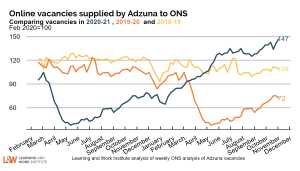November 2021
The labour market continues to recover, with the number of payrolled employees above pre-pandemic levels
Employment rose by 247,000 in July to September 2021 compared to the previous quarter but remains 550,000 lower than before the pandemic. The timelier but less comprehensive measure of PAYE employees increased by 160,000 in October 2021 compared to the previous month and is above its pre-pandemic level.
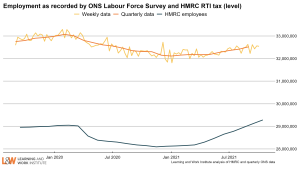
Early signs suggest there was a relatively small share of redundancies at the closure of the furlough scheme
At the end of September 2021, the total number of people furloughed stood at 1.14 million, of whom 640,000 were fully furloughed. There is little sign of a significant adverse impact from the ending of the Job Retention Scheme in the available numbers for October. The claimant count continued to fall, albeit by less than has been seen in recent months, and the increase in HMRC numbers for payrolled employees is similar to previous months. The ONS’ Business Insights and Conditions Survey (BICS) found that in late October 2021, 87% of formerly furloughed employees had returned to work. Similarly, a survey by the Resolution Foundation suggested that 88% of employees who were furloughed in September were working in October, with 3.4 percent unemployed and 8.5 per cent having left the labour market and become economically inactive. This translates into 136,000 of those furloughed in September not being in work in the first half of October, with a rise in unemployment of around 39,000, and a rather larger increase in inactivity of 97,000. The Government needs to ensure those who lose their jobs are supported to find new work, rather than dropping out of the labour force.
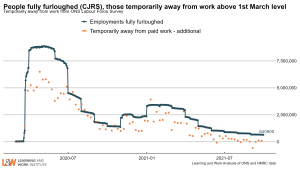
Long term unemployment continues to rise among older adults
Long-term unemployment is a particular concern as it reduces people’s chances of finding work and can reduce their health and wellbeing.
Long-term unemployment rose significantly through the pandemic, and is continuing to worsen for adults over 25, while improving for young people. The number of people aged 25 and over who are long-term unemployed, defined as out of work 12 months or more, has risen 132,000 (55%) since the pandemic started (Dec 19-Feb 20). Youth long-term unemployment (defined as six months or more out of work) is up 18,000 (12%) since the pandemic began.
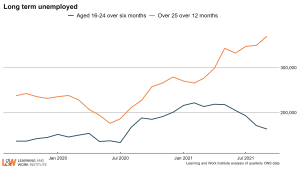
Inactivity remains stubbornly high with a sharp rise in long term ill health
Inactivity remains high at 21% or 8.7 million 16-64 year olds not in employment and not actively seeking work. Over 1.7 million of them want to work. Overall, there are 3.2 million people who are either unemployed or economically inactive but want a job.
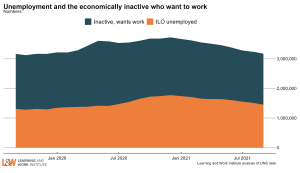
A particular concern is that the number of people inactive due to long-term sickness or disability has been accelerating over the last few months. This is a large group – 2.3 million people under 65 – and has risen by 6.3% in the last quarter. This could be a direct impact of COVID, with people suffering longer term effects, and also indirectly, with people who were required to shelter at home continuing to do so. In previous recessions, policy as seemingly shifted from trying to help people with disabilities and health conditions into work to supporting other groups seen as easier to help. It is important this does not happen again.
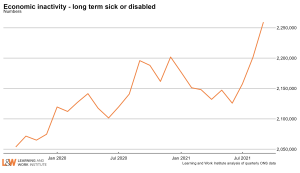
We need to accelerate our efforts to support those who are out of work to look for jobs. The number of people claiming unemployment-related benefits fell by 14,900 in October 2021 compared to the previous month, meaning the number of people claiming benefits both in and out of work now stands at 2.06 million. While it doesn’t show an increase following the end of furlough, it is a smaller fall than previous months.
Strikingly this is 614,900 above the survey measure of unemployment, having been below this measure for most years prior to the pandemic. This suggests there are significant numbers of people who are classed as receiving unemployment-related benefits, but who are not either looking for work or available to start work. The Government has invested in increasing Jobcentre Plus capacity and extended new employment programmes. This support needs to deliver.
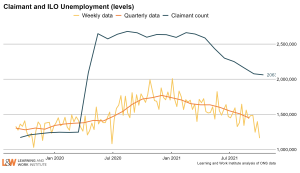
Meanwhile, vacancies remain at record levels and 63% above pre-pandemic levels, with 1.3 million vacancies recorded in October. Later online vacancy figures show continued rises into November. While this varies by sector and geography, vacancies are higher in virtually all sectors and areas of the country than pre-pandemic.
